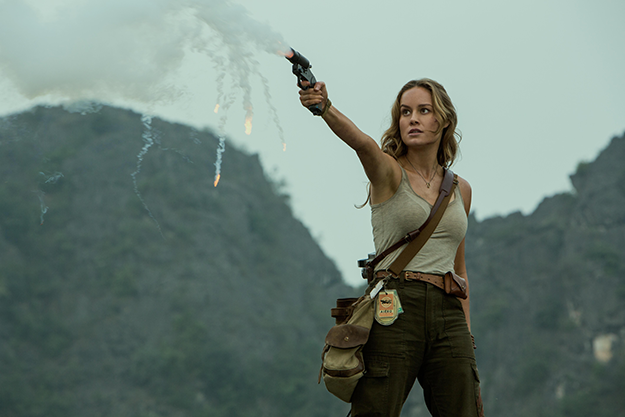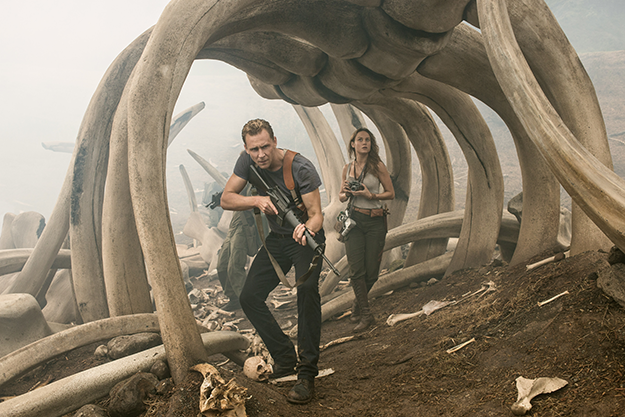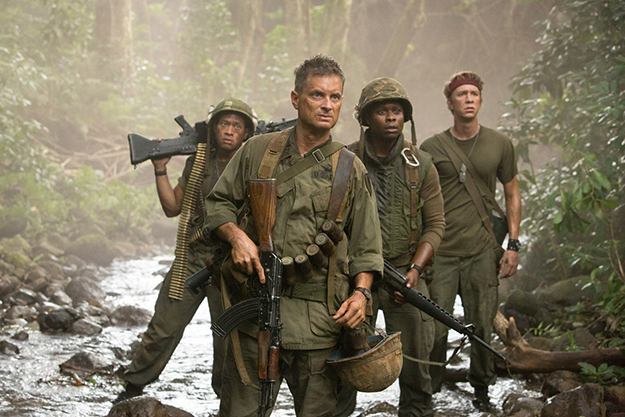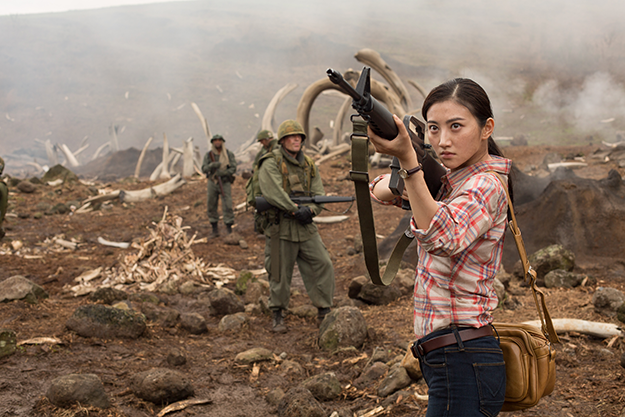Deep Focus: Kong: Skull Island

The theme song for Kong: Skull Island should be “If I Only Had a Brain.” A human brain, that is. This film epitomizes artificial intelligence, untouched by inspiration or spontaneous emotion. As a piece of marketing it’s a masterstroke, not only as a reboot of the King Kong mythology, but also as the second chapter in the emerging Warner Bros./Legendary Pictures “MonsterVerse” that will lead, in a couple of installments, to King Kong Vs. Godzilla. Since Warner Bros. also controls the DC Comics Universe, we must wonder: Will Kong some day fall in love with Wonder Woman? Will they and Godzilla team up with Batman against Superman? Will it be long before we see The Lego King Kong Movie? As the ad line went for Bob & Carol & Ted & Alice, “Consider the possibilities.”
In this version of the great pop fable, Kong never leaves his island or falls hard for a human woman. Rather than update the movies’ most harum-scarum Beauty and the Beast, this film simply gives us The Beast and Lesser Beasties. The director, Jordan Vogt-Roberts, operates more like a packager than a moviemaker. He appears to have approached this movie as a contest to see how many saleable ingredients and movable parts he could pack into two hours and keep it running like clockwork. He filches elements from action and fantasy films of every type, from Treasure Island to Apocalypse Now. Most of all, he wants to follow in the footsteps of the financially successful, creatively inert Legendary/Warner Bros. Godzilla (2014).
Kong: Skull Island shares with that giant-lizard smash the central tenets of the MonsterVerse. Primordial beasts exist in a world that is otherwise exactly like our own. An enigmatic government agency named Monarch has been attempting to chart and destroy these “MUTOs”—massive unidentified terrestrial objects—but it usually ends up rousing them from beneath the earth’s surface. In the MonsterVerse Godzilla, the title character is a cleverly inflated variation on the beloved dinosaur/dragon, while the supporting MUTOs draw on images from Jaws, Alien, and Starship Troopers, as well as big gorilla movies. As far as I can make out, this Kong is not a bona fide MUTO. He’s an overgrown adolescent ape, an alpha predator in an isolated island eco-system that also contains super-sized water buffalo, calamari that can kill you, and arachnids with towering and deadly bamboo legs. The truly evil species live in primal lairs beneath the ground and use Skull Island as their portal.
Kong: Skull Island does a better job than Godzilla of teasing the presence of the title behemoth early on and explaining his function as the protector of his imperiled kingdom. But the Bosch-on-steroids creatures known as “Skull Crawlers” eat up screen time that would have been better spent establishing the connection between the super-simian and the humans.

An earlier Godzilla reboot (1999) famously declared, “Size Does Matter.” Vogt-Roberts seconds and thirds that motion in the way he’s made Skull Island. The Kong of this movie is a hundred-foot hominoid who can swat away U.S. combat helicopters like annoying gnats. At first the sight is startling, but soon the thrill is gone. When Kong looms so large in the pilots’ vision, we question why they keep heading straight into his path. Worse, it’s hard to put across a mammal this enormous making eye contact with humans even when they’re as striking and sympathetic as Tom Hiddleston, who plays Monarch’s tracker on the Skull Island expedition, and Brie Larson, who plays the cameraperson recording the adventure on her trusty Leica. We don’t buy that she forges a bond with the hairy monarch when they team up to help a gentle, injured animal. They don’t conjure an ounce of platonic romance. Theirs is strictly a friendship of inconvenience.
In all his previous major incarnations, Kong had a complex and endearing character. This Kong, a creation of both motion-capture and animation, has zero personality. Where is Kong as the ultimate Wild One, or the jungle deity forced to become an urban gorilla-guerrilla, or (to borrow from Jack London) “God’s own mad lover, dying on a kiss”? The 100-foot Kong is just one stupendous blank with a hundred-mile stare. We look into his deep brown eyes and we see next to nothing looking back. For old movie-lovers, it may be like discovering that a beloved pet is a sociopath.
Vogt-Roberts’s supposed coup de théâtre is setting this prefab fantasia in 1973, during the thick of Watergate and the waning days of the Vietnam War. This way, when John Goodman, as Monarch honcho Bill Randa, says, “Mark my words, there’ll never be a more screwed-up time in Washington,” we can all laugh knowingly, without our sensibilities being trampled or Trumpled. We get a similar invitation to pseudo-sophistication when Samuel L. Jackson, as Lt. Colonel Preston Packard, decides that no détente is possible with a king-sized ape, even when it becomes clear that Kong kills only those humans who threaten his turf.
Randa kicks the main action into gear when he tells a U.S. senator (Richard Jenkins) that NASA satellites have revealed the existence of a South Pacific land mass hidden beneath a perpetual storm system. Randa argues that if Monarch doesn’t find out what’s going on there, the Soviets surely will. With D.C. backing comes Packard’s crack chopper team, the Sky Devils, and enough money for Randa to hire Hiddleston’s Conrad, a British Special Forces op. Rounding out the key personnel are Larson’s Weaver, an “anti-war photographer” who senses that Randa is onto a major find, and, halfway through, John C. Reilly as Hank Marlow, a fighter pilot who crashed on the island in the waning days of World War II and has been there for 28 years. Marlow’s knowledge of Skull Island proves as crucial to the film’s eventual heroes as Ben Gunn’s knowledge of Treasure Island did to Jim Hawkins and his buddies. Reilly does give by far the most colorful and amusing human performance, but the critical embrace of this once-stock character—the stranded eccentric—belongs to the department of “everything old is new again.”

The plot is strictly a matter of survival. As soon as Packard’s fly-boys cut through the storm system and start dropping bombs (part of Randa’s secret plan to flush out MUTOs), Kong raises his monumental head, the military and Monarch teams (including members of NASA’s Landsat program) come crashing to the ground, and two small squads of survivors try to make their way to a planned extraction point. Chases and ambushes ensue and the body count escalates.
The historical setting allows us to assume hip political attitudes. It’s no artistic gain. Vogt-Roberts hot-peppers the soundtrack with period hits from the Chamber Brothers, Jefferson Airplane, David Bowie, the Hollies, Black Sabbath, and the inevitable Creedence Clearwater Revival (“Bad Moon Rising,” “Run Through the Jungle”). But the combination of evocative music and crisp green-and-umber imagery never whips up a psychedelic aura. Vogt-Roberts keeps the action perky with editing tricks, like smash cuts between a human falling into Kong’s jaws and a man chomping into a sandwich, or with gimmicky staging, like revealing pieces of landscape as living bodies or plunging monstrous attackers into the frame from just beyond our peripheral vision. The only time the director summons some genuine eeriness is when Conrad and Weaver come face to face with Skull Island’s native Iwi people. They tattoo and decorate their skin with elaborate symbols that also serve as camouflage. It’s as if they step right out of the scenery.
Vogt-Roberts’s Kong: Skull Island is the latest example of a supposedly “indie” moviemaker chosen to bring fresh creative blood to a franchise. Actually, Vogt-Roberts’s coming-of-age comedy-drama The Kings of Summer (2013) was just a Tinkertoy contraption on a smaller scale, notable for connecting odd details like the sloughed-off skin of a copperhead and a sword slicing through a watermelon. Its performances were no deeper or more textured than the ones in Skull Island, but the scale of this film exposes the actors more cruelly: Jackson’s grim determination as Packard (who is no Captain Ahab) or Larson’s generalized intensity as Weaver (what an ironic gig for the performer who deservedly won an Oscar for Room).
What’s fatal to this movie is that it lacks visionary gusto. In the original 1933 classic, Ernest Schoedsack and Merian C. Cooper caught every playful bit of Willis O’Brien’s sensual stop-motion Kong while imbuing a Gustave Doré atmosphere on Skull Island, and the action scenes both there and in New York, with essence-of-awesomeness. With the help of Fay Wray’s mighty lungs and forthright emotions as Kong’s lady, they built up some powerhouse poignancy. In the 2005 remake, Peter Jackson used digital technology and Andy Serkis’s inspired motion-capture performance to portray Kong as a super ape with the brainpan of DC’s super-intelligent Gorilla Grodd and a scrambled version of Superman’s power menu: faster than a locomotive, more powerful than a speeding bullet, able to leap tall jungle walls in a single bound. Jackson and Naomi Watts went further with the love story, triggering primal hopes that sympathy and beauty connect God’s creatures great and small. I always enjoyed Jackson’s film, despite its excesses; now I consider it a blend of nostalgia and magic on the scale of Sergio Leone’s Once Upon a Time in America.

Even in the maligned 1976 version, Jessica Lange (in her debut!) brought the female lead irresistible mischief and pliancy, while the model-work of Carlo Rambaldi, along with Rick Baker’s artistry with a gorilla suit, drew us in to every shade of Kong’s rage, lust, and romantic longing. Making their film just a couple of years after Kong: Skull Island is set, director John Guillermin and screenwriter Lorenzo Semple Jr. came up with an idea that now feels more authentically Seventies: an oil-company executive goes to Skull Island to plunder its untapped resources, then finds Kong and brings him back as a marketing bonanza. He asks how anyone could seriously compare Esso’s cartoon big cat in its call to “Put a Tiger in Your Tank” to his own ultra-large ape.
In Kong: Skull Island, the period, like everything else, feels pasted-on—a way of fitting into the existing MonsterVerse chronology rather than pioneering a fantastic, brave new world. In the other Kongs, “It was Beauty killed the Beast.” In Kong: Skull Island, ’twas the franchise.
Michael Sragow is a contributing editor to Film Comment and writes its Deep Focus column. He is a member of the National Society of Film Critics and the Los Angeles Film Critics Association. He also curates “The Moviegoer” at the Library of America website.







